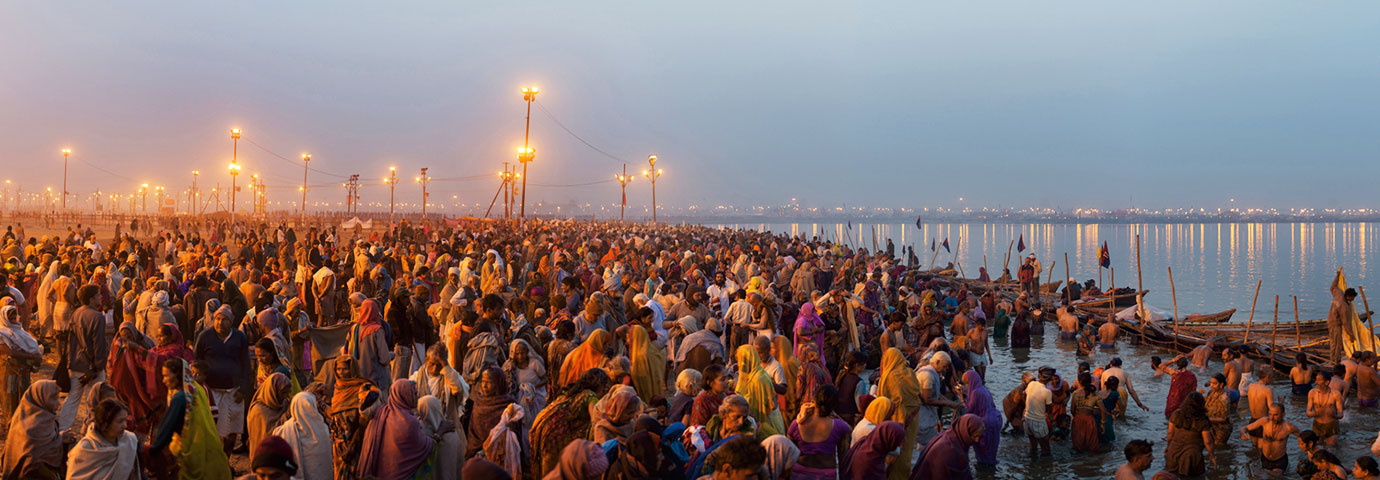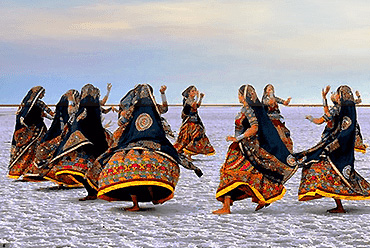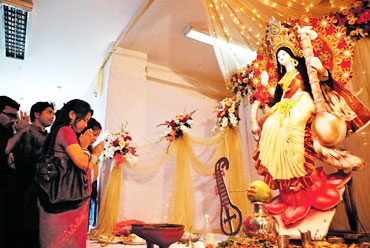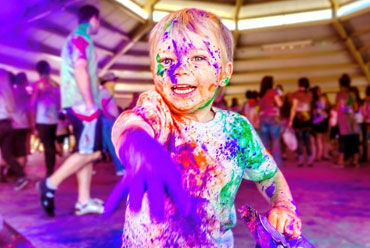The Kumbh Mela is the greatest of the north Indian fairs and it has exerted a mesmeric influence over the mind and the imagination of the ordinary Indian from time immemorial. It is held once every three years by rotation, on the banks of the Godavari in Nasik, the Shipra in Ujjain, the Ganga in Haridwar and the confluence of the Ganga, Yamuna and the mythical Saraswati in Prayag or Allahabad as it is called now. The Purna (complete) Kumbh or Maha Kumbh, the biggest and the most auspicious fair, which falls once every 12 years, is always at Allahabad, for the Sangam or confluence of rivers is considered to be particularly holy. The last Maha Kumbh was held in 1989. When the particular configuration of the Kumbh at Allahabad falls on a Monday, it is called the Somvati Amavasya and the spiritual benefits increase manifold. The Purna Kumbh is followed by the Ardh Kumbh in importance and this fair falls every six years when millions of devout congregate at Allahabad on the banks of the holy river, braving the hazards of cold, disease, hunger and a myriad other privations, to gain spiritual salvation and contentment.
History
Historically speaking, the roots of the Kumbh can be traced to the river festivals in which pots of grains were soaked in the waters of the holy rivers and put to seed, with the rest of the grain during sowing time. It has also been considered to be a pre-Aryan fertility ritual, for the Kumbh symbolizes not only the Mother Goddess but also the womb, the generative pot. Rivers, as givers of life and agents of fertility, became tirthas (holy places) as they act as bridges between heaven and earth, the human and the divine.
Credit for organizing the Kumbh into a congress of Hinduism, where rishis, munis, sadhus and yogis gathered to discuss and debate upon the finer points of their faith and disseminate their religion, goes to the seventh-century Shaivite philosopher and religious guru Adi Shankaracharya. He infused new life into the tottering citadel of Hinduism, which had been badly battered by the breakaway religions of Buddhism and Jainism, by organizing the Kumbh Mela.
Legends
The origin of Kumbh, which is an ancient and continuing element in the Indian ethos, extends backwards into mythology. The story is related with some variation in the Ramayana, Mahabharata and the Puranas. According to one source, the gods, who had been defeated by the demons, approached Vishnu, the preserver of the universe, seeking the boon of rejuvenation and the gift of immortality. Vishnu directed them to the primeval ocean in which were hidden the secrets of life and death. The gods sought the help of the demons, to whom they promised part of the spoils. Making a paddle out of Mount Mandar and a rope out of serpent Anant Nag, they churned the ocean till it yielded the holy cow and the flying horse, the lyre and the siren, Lakshmi and Vishwakarma. Finally, Dhanvantari, the divine physician, emerged holding the Kumbh (pitcher) of Amrit (the nectar of life) that could bestow immortality. As both the demons and the gods lunged for the pot, Dhanvantari changed himself into a rook and flew off to the heavens, with the pitcher. On his journey, which lasted twelve days, he rested at four spots-Prayag, Nasik, Ujjain and Haridwar-which have consequently been consecrated by drops of nectar that fell there. Therefore, these places are considered holy by the Hindus and have become important pilgrim spots.
Then there is story that neatly sums up the attitude of the ordinary Hindus to the Kumbh. According to this, as Parvati, the consort of Lord Shiva, watched the millions gather at the holy Kumbh, she became pensive and turning to Shiva said "You are indeed compassionate my Lord, but to me it seems your compassion has done more harm than good for only a fool would lead a virtuous life when Moksha can be attained by a mere dip in the holy river." On hearing her complaint, Shiva suggested that they pay a visit to the Kumbh. Taking the form of a Brahmin couple, Lord Shiva lay prone on the ground while beside him Parvati sobbed profusely like a bereaved wife. When the pilgrims stopped to enquire about her plight, she answered all queries by saying, "Lord Shiva has promised that the mere touch of a sinless man can bring my husband to life. But if the person is not sinless, he will die instantly." On hearing this all the pilgrims recoiled, for none of them truly believed that they had been cleansed of their sins after the holy dip. Thus the widow sat crying, until a drunk came staggering along and as soon as he found out her problem, he was certain that a dip in the river would purify him. After a quick dip in the river, he returned and bent down to touch the dead Brahmin, whereupon Shiva revealed himself and said, "You indeed attained Moksha my son, so far only you." Back at their heavenly abode, Shiva asked Parvati, "With all my divine compassion I do not seem to have succeeded in making salvation so very cheap, after all, have I?
The Special Attractions
The Kumbh Mela became an important meeting ground for the devout Hindus and its importance has not diminished over the years. Even today, millions of pilgrims from all over the world, from various walks of life, sects and communities, gather at the Kumbh. For most it is a once-in-a-lifetime trip. They probably plan and save over many years to make this visit to the king of tirthas, the Purna Kumbh, seeking salvation. For thousands of traders, shopkeepers and pedlars who gather there, the mela means business and profits. Many come to enjoy the lively and colorful bustle of crowds buying curios and magical stuff and generally having fun. It is both a holy day and a holiday for the people.
Rituals And Traditions
The main rite performed at the mela is the ritual bath. Orthodox Hindus, who give great importance to the performance of ritualistic action, believe that a dip in the sacred waters on the auspicious day will cleanse them and their ancestors back to the eighty-eighth generation, off all evil and sin, thus ensuring their salvation or freedom from the cycle of death and rebirth. Ritual bathing is a public act and is performed in the open and ideally on the banks of a river or stream. It includes the complete submergence of the body under water and an oblation to the sun. The most auspicious day for the ritual bath at Kumbh is on the day of the new moon.
The ascetics and sadhus are an integral part of the Kumbh. One of the aims of all devout Hindus, who make a pilgrimage to the Kumbh, is to have darshan of these holy men. By touching their feet and listening to them, their followers hope to gain spiritual enlightenment.
The most conspicuous sadhus at the Kumbh are the Nagas or naked sadhus. The Nagas smear their bodies with ash and sport long matted hair. Constant exposure to the elements and rigorous self-control makes them impervious to the extremes of hot and cold. They ever need to adjust their clothing to suit the weather. Originally a militant armed band, the Nagas were recruited to defend the ascetics who had taken the vow of nonviolence and therefore could not retaliate when hostile Buddhist, Vaishnavite or other monastic orders attacked them. The eyes of the Nagas are usually red with the intake of charas and ganja, which is also considered to be one of the means of attaining siddhi (greatness).
Besides the Nagas, there are several other types of sadhus-the Urdhwavahurs who practice severe physical austerities and their bodies are usually emaciated and limbs shriveled; the Parivajakas, who live under a vow of silence and go about tinkling little bells to get people out of their way; the Shirshasins who stand all 24 hours and sleep with their heads resting on a vertical pole attached to an oblong pole or meditate for long hours standing on their heads; and the Kalpvasis, who spend the entire month of Kumbh on the banks of Ganga, meditating, performing rituals and bathing thrice a day.There are also thousands of godmen among the bustling crowds, who try to outdo each other in selling themselves. Many guarantee peace, freedom and salvation over loudspeakers competing raucously for attention.
On the day of the new moon, the day begins at about 3 AM, when the first pilgrims line up for a dip in the river. Scantily clad, they chat non-stop 'Jai Ganga Maiya' (long live mother Ganga). When they finish, they leave quickly, to make way for the next lot of bathers. Most of them shave their heads before the holy bath, as it is considered a part of the ritual.
With the first rays of the sun, the processions of akharas or groups of sadhus of a particular sect begin. The different sects of sadhus move in the form of a procession towards the river. The processions are usually led by the Nagas. A messenger who carries a turban aloft a pole precedes every akhara at the Kumbh, announcing their arrival. There is an air of ostentation about these holy men. The heads of the sects move in golden chariots, with silk umbrellas and leopard-skin rugs. All the akharas try to outdo each other in terms of grandeur and fanfare. The endless crowd surges towards the Sangam, the magnet that draws them all together. Everyone is absorbed in the magic of the moment.
After their minds and bodies have been cleansed by the purificatory dip, the pilgrims don fresh clothes and proceed to perform puja on the riverbank. After having had their meals, the pilgrims walk around listening to discourses of various sadhus or have a darshan of the well-known godmen. By next morning the pilgrims are ready to leave. Some stay back a few days, weeks, even a month, but eventually they depart in the belief that all their sins are cleansed and that they have achieved spiritual salvation.





